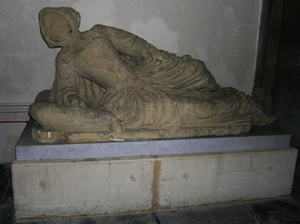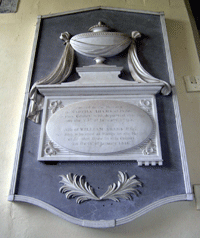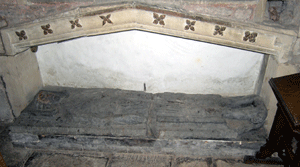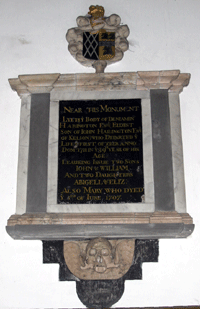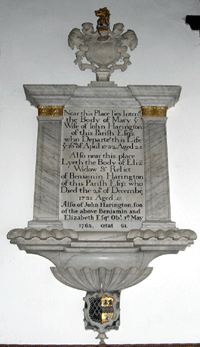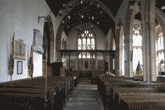| SOMERSET 2 |
| Cameley - St James Several monuments by Reeves of Bath |
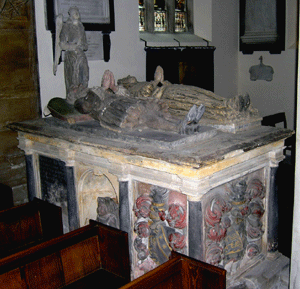 |
Camerton - St Peter |
.gif) |
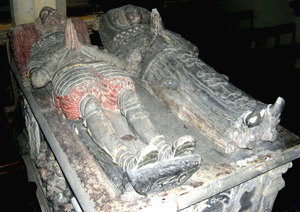 |
||
| John Carew (1683)
and her wife, Dorothy (Hippisley) Note that the angel stands at the head not the feet as has been stated. Note the children seated in the tomb chest centre niche on either side |
John Carew (1638) and his wife, Elizabeth Southcote | John Carew (1683) and Dorothy see far left |
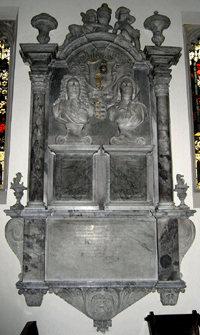 |
|
 |
||
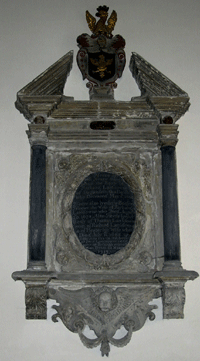 |
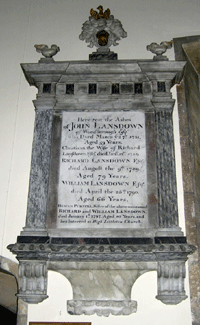 |
| Cannington - St Mary
Wall monument (1792) by King of Bath |
Carhampton - St John Baptist Brass inscr. to Escott family (1755) by C Sherborn, Gutter Ln, London |
Castle Cary - All Saints
John Russ (1758) by John Ford |
| Chard - St Mary the Virgin William Brewre (1614) |
Charlton Adam - St Peter & St Paul Thomas Basket (1592) 2 Strangeways (17th C) slate |
Charlcombe - St Mary Lady Barbara Montague (1765) female leaning on pedestal by Ford |
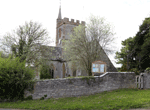 |
Charlton Mackrell St Mary the Virgin |
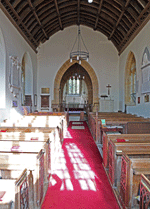 |
| Church open from about 9.00 am to 5.00 pm.
Best to avoid Tuesday morning and Thursday afternoon when the
church is in use. Park in school car park opposite the church.
Can be hard to find: look for school road sign. The church is
south of the railway line which cuts the village in two.
O/S Ref : ST 528 282 |
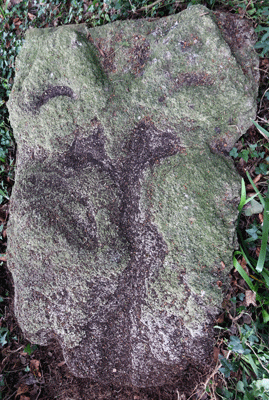 |
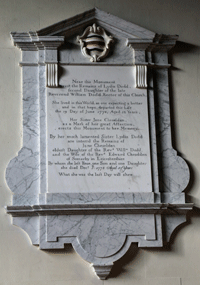 |
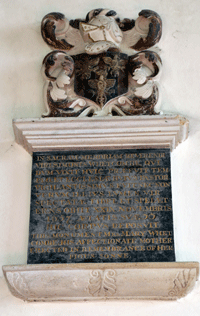 |
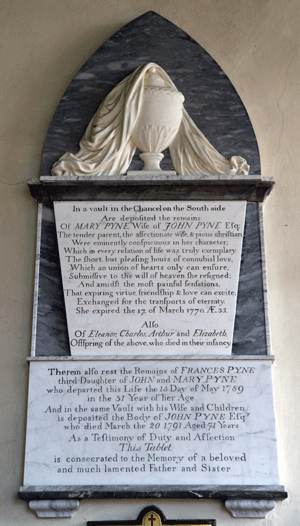 |
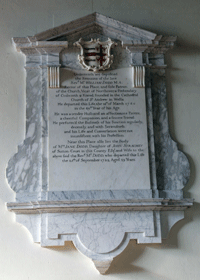 |
| Left and from left to right above: Effigies from double tomb said to be that of Sir William Lyle (1316) & Agnes. They were cast out of the north transept during the restorations of 1847 and are now in a sorry state east of the church under a yew tree. The arch under which they are said to have originally situated is in the north wall of the north transept although this is now totally obscured by the organ; you can just see the beginning of the arch by peeping through the gap at the side of this instrument. The effigies have gablettes over their heads; the knight appears to be drawing - or more likely, sheathing, his sword while the lady's hands may well be held in prayer. A great loss. 1. Lydia Dood (1778) The rector's 2nd daughter and Jane (Dodd) Cheseldon (1778), his 1st. 2. Rev Simon Whetcombe (1657), curiously in Latin and English. 3. 'In a vault...depoſited the remains of...' Mary Pyne (1770) Also Eleanor, Charles, Arthur & Elizabeth, 'offsping...who died in infancy'. Added below Franes Pyne (1787) 3rd daughter. John Pyne (1791) the husband of Mary. 4. Rev William Dodd MA (1760) 'Rector of this place, ſole Patron of the Church, Vicar of Northover & Prebendary of Cusworth & Knowl founded in the Cathedral Church of St Andrew in Wells.' Mrs Jane Dodd (1732) | ||||
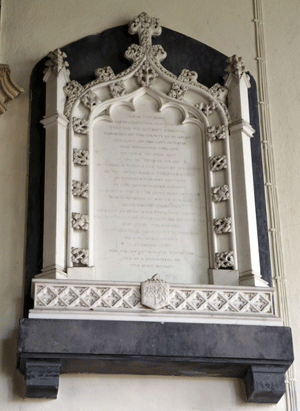
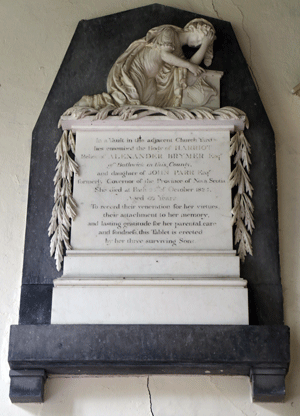 Top left: Thomas Wilkinson (1827); Top right: Harriet Brymer (1825); Right top: George Page (18--); Right bottom: Rev Richard Ford (1817) rector |
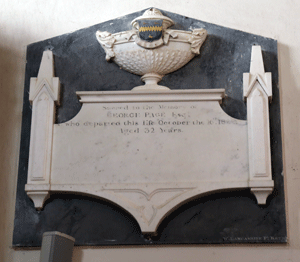 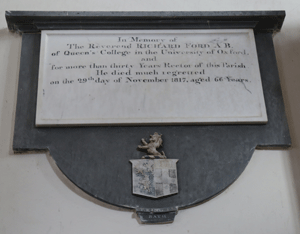 |
| Cheddar - St Andrew Sir Thomas Cheddar (1443) brass on tomb chest Lady Cheddar (1460) wife to the above- brass on floor |
| Chedzoy - St Mary |
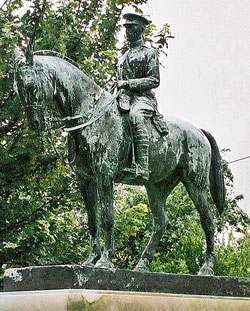 |
| Sydney Mason Collins TD MA ESA
(1946) He was a barrister-at-law and served throughout
Word War I with the Signals; he is shown on horseback and in
uniform. The bronze statue is five feet in height and stands on
a plinth of the same height. It was erected in the church yard
in 1950. The statue was stolen in 2006 Also: Richard Sydenham (c 1490) brass |
| Chelvey - St Bridget Military incised slab (c 1260) |
Chilton - Polden Tablet with draped urn by James Allen of Bristol |
Clapton -in - Gordano - St Michael Edmund Wynter (1672) & Wife figures kneeling facing across a prayer desk with daughter sitting frontally underneath. |
| Claverton - St Mary William Bassett (1613) & Wife frontal three quarter figures |
Clevedon - St Andrew Military (c 1420) incised slab John Kenn (1593) tomb chest, no effigy Phillippa Wake (17th C) recumbent figure of child from a tomb |
Cloford - St Mary Maureis Horner (1621) tomb chest, no effigy Sir George Horner (1676) hanging wall monument with two three quarter figures |
| Combe Hay Robert Smith (1755) two urns on an obelisk by Ford of Bath |
Congresbury - St Andrew Mary Merle (1851) white sarcophagus in relief decorated with flowers by T Tyler of Bristol |
|
|
|
||||||||||||
 |
Chew Magna - St Andrew |
 |
| Church open during normal hours. Park in the village or in the free car park across the road from the church. O/S Ref: ST 577 632 |
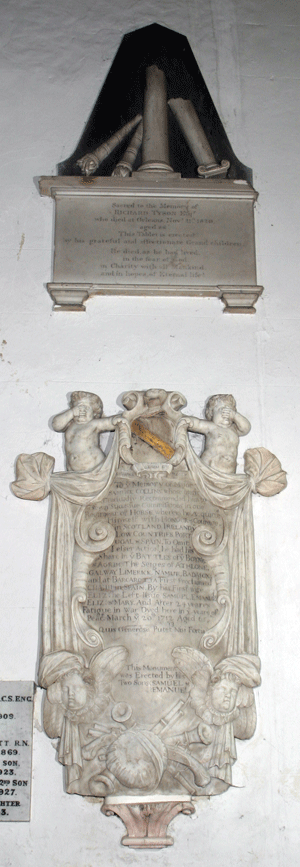 |
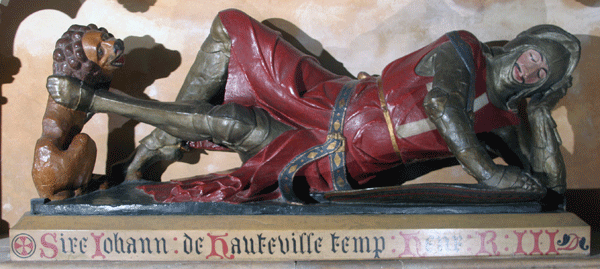 |
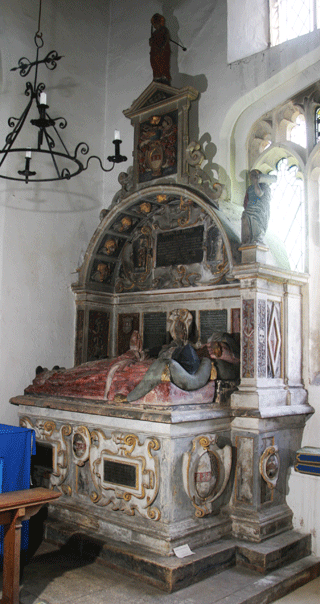 |
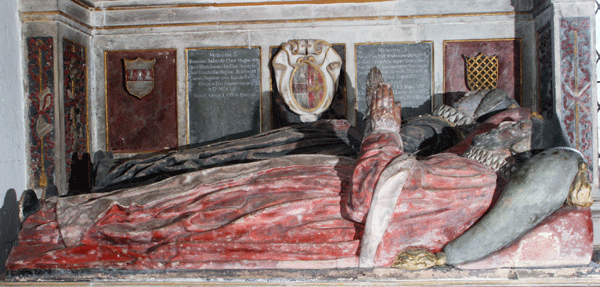 |
||
| Left Top: Richard Tyson (1820); Left Bottom: Samuel Collins (1712); Centre Top Wooden monument on which is painted 'Sire Johann de Hauteville temp R III'. Despite this inscription, it is not Sir John Hautville, the last of that name dying two hundred years before the type of armour indicated was worn. It was repainted in the 1860's. Pevsner states it may be a Tudor retrospective although is thought to be of Sir John Wych (1340-1350). Compare the similar effigy (although of stone) in Aldworth, Berskshire. However, Dr Claude Blaire confirms that this interesting monument is indeed medieval. Centre Bottom and Right: Sir John St Lo (1447) & Agnes (second wife or another St Lo). It is said that these effigies may not have been made as a pair. | ||
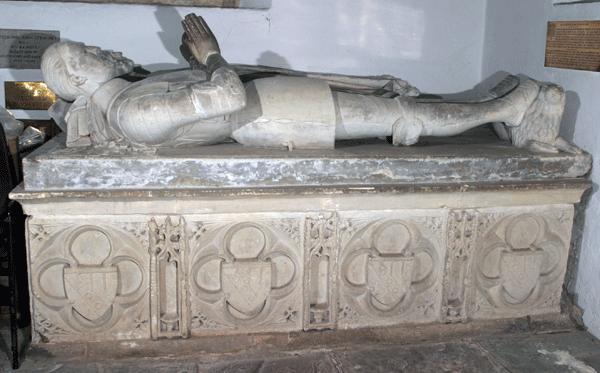 |
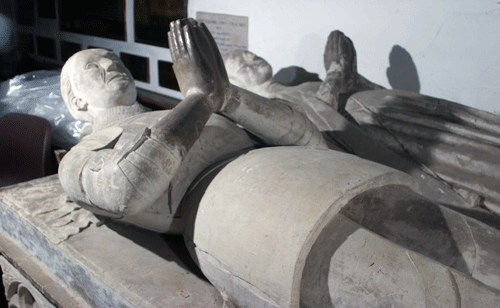 Left & Above: Sir John St Lo (1447) and Agnes (second wife or another St Lo). It is said that these effigies may not have been made as a pair. |
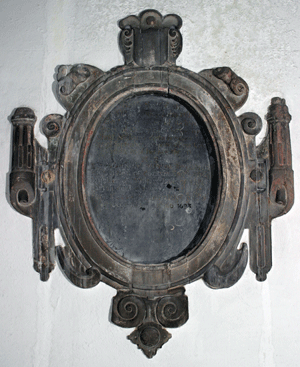 |
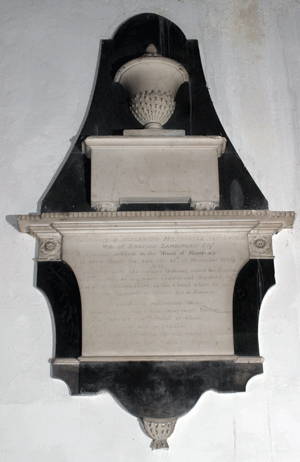 |
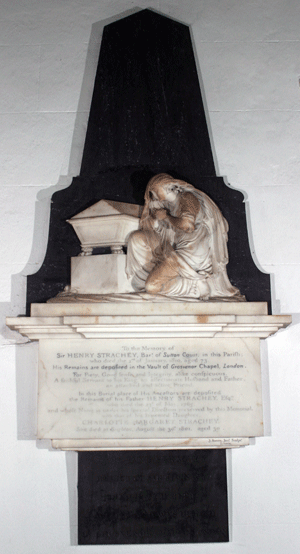 |
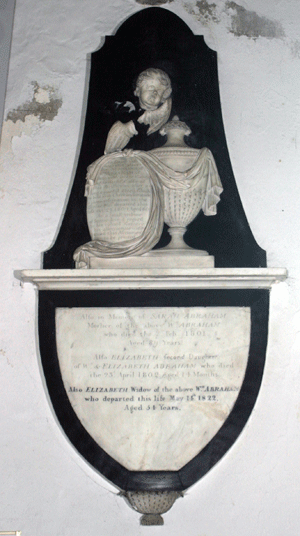 |
| Above Left: Frame of damaged monument. Above Right: Elizabeth Henrietta Sandiford (1800). Right:Sir Henry Strachey Bart by J Bacon Jnr of London Far Right: Sarah Abraham (1801) | |||
|
 |
Chilthorne Domer - St Mary |
 |
| Church open. Park in road outside. O/S Ref: ST 524 194 |
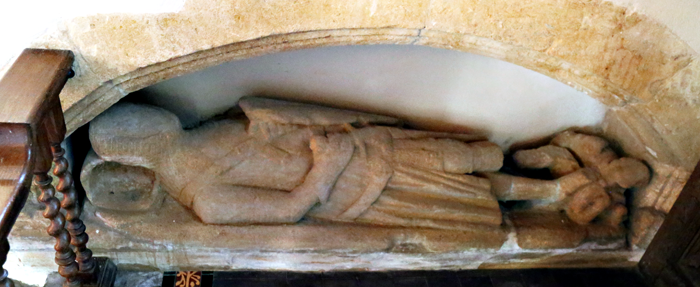 |
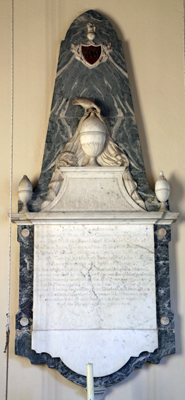 |
| Above:
Knight c. 1275 Right: 'In a Vault underneath (together with ſeven of her Children who died as Infants) are depoſited the Remains of Elizabeth...' Browne (Rice) (1724) That is a pecking bird on top of the urn. |
| Rev George Daunt MA. Rector 1937-52. The altar rails were given in his memory | Simple white tablet with small cross |
| Rev Robert Palmer (1914) Missionary in China eight years; Rector of parish twenty-four years | White pointed arch tablet on gray base |
| Rev William Taylor Dixon (1884) and his wife Jane Isabell (1884) Vicar for twenty-four years | Similar but slightly more elaborate |
| John Bayly (1857) Vicar for forty-three years. His first wife, Lucy (1823) and his second wife, Mary (1836) | White tablet |
| Churchhill - St Andrew |
| You can park in a small road, just outside
the church; however, even though I wrote to the church
before my visit I received no reply and the church was locked.
There are several monuments inside the church including a
fourteenth century knight and lady inside the porch. These may
be seen but the porch in closed by an tall iron grill gate,
the bars of which are too close to push my camera through and
far too high to hold a camera over the top. O/S Ref: ST38 603 |
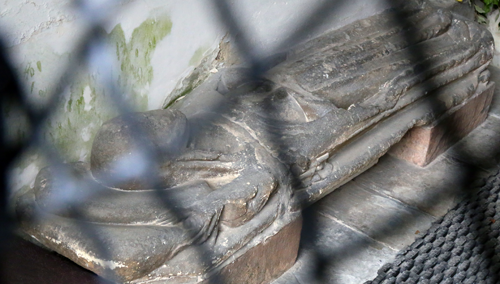 |
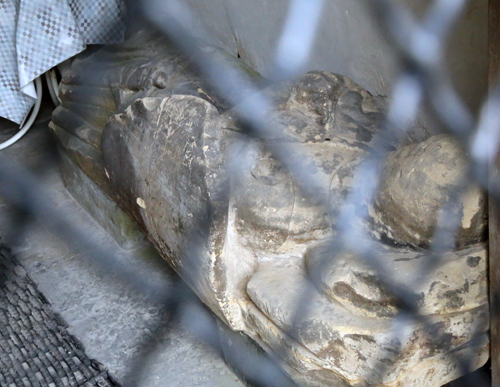 |
| Sir Roger Fitzpaye (1322)
and presumably his wife. Taken through the porch gate grill |
| In the body of the church (not seen) |
| Ralph Jennys (1572) and unamed wife In South Aisle |
| John and Sarah Larch (1644) Reclining figures |
|
|
Combe Florey - St Peter & St Paul |
|
| Church normally open. Park in the village. O/S Ref: ST 151 312 |
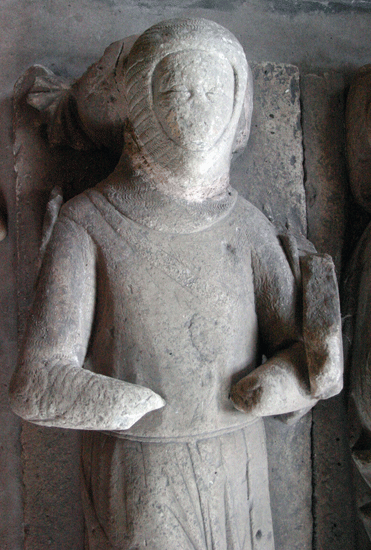 |
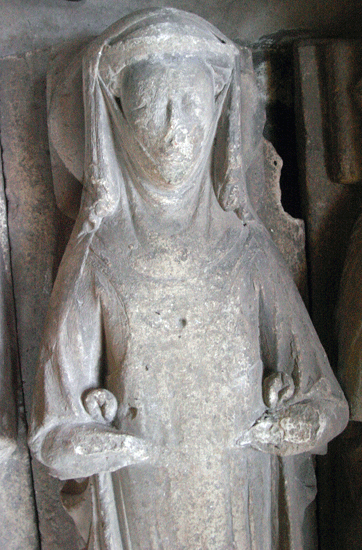 |
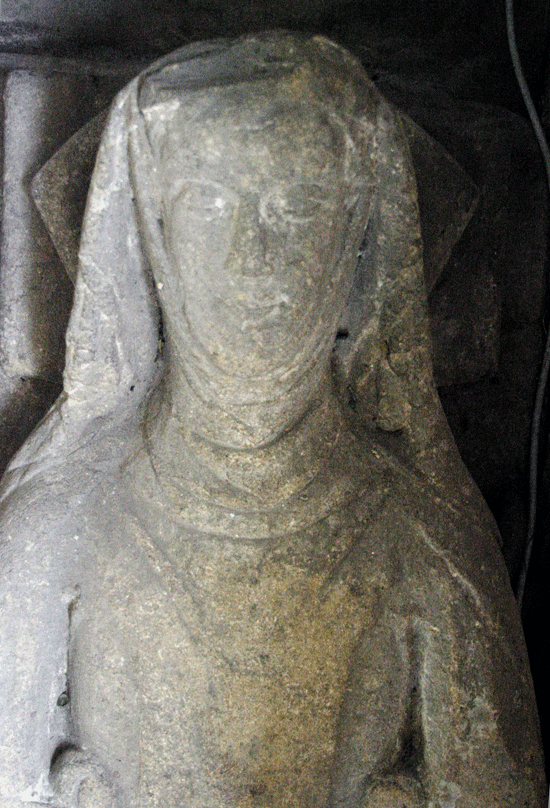 |
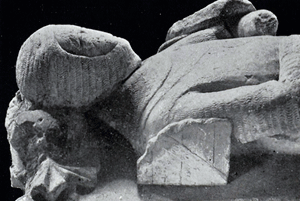 Above and Right: Knight and two ladies - now on floor. Said to be Sir John de Meriet of Hestercombe, who died in 1327, and his two wives, Mary de Bohun (1314) and Elizabeth Paynes (1334). The date is early 14th century - note the beginnings of plate armour on the lower limbs. Also note the structures on eithershoulder of the knight, particulalry as shown in the photograph on the left: these are ailettes, which can be seen quite clearly here to have served at least a heraldic function. These are very rare on medieval effigies but when they appear on brasses are illustrated as facing forwards. |
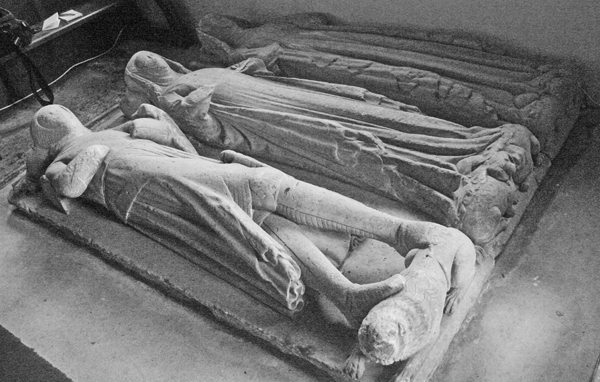
|
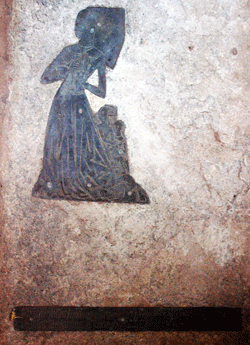 |
 |
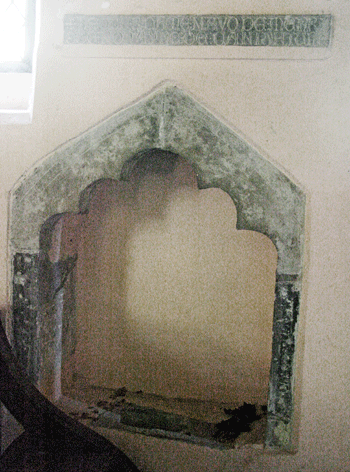 |
||
|
Left: Brass to Florence Fraunceys (c 1550) and two children, although probably made when her husband died in 1485. Relaid in indent for husband, John. Shields and inscription are lost. Above: brass inscription to Nicholas Fraunceys (c 1485) two figures and scrolls lost. Right: This is said to be a heart shrine of Maud de Meriet, a nun at Cannington. There is a circular (with appendage) recess in the floor of this structure (with no drain) and an incised inscription above. |
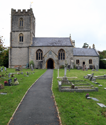 |
Cossington - St Mary |
 |
| Park outside the church - very limited - and look for the church gate. Church is open. O/S Ref: ST 357 403 |
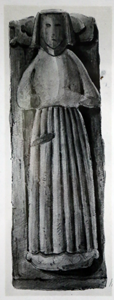 |
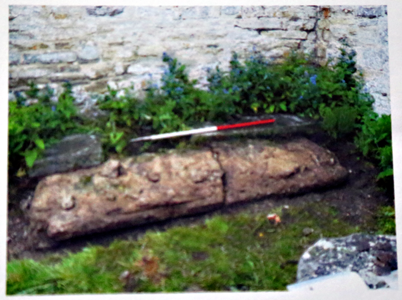 |
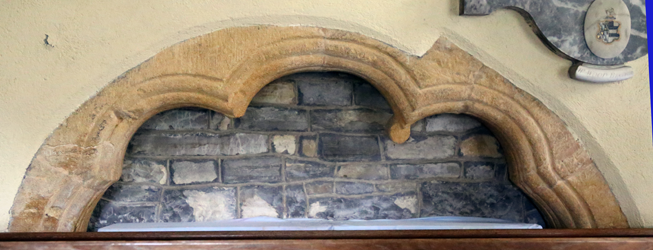 |
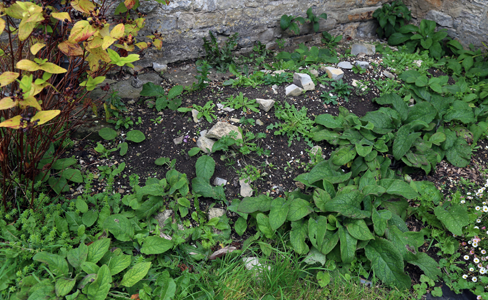 |
Pevsner reports: 'outside the porch effigy of a lady, c. 1375; in a decaying state'. This is not strictly correct. There was an effigy of a lady in the chancel, possibly under the arch shown above; above this is a photograph of a drawing of the effigy displayed in the church. During a 'reordering' in Victorian times she was ejected from the church and buried in the church yard east of the porch. The church warden was in the church and told us that the effigy had been excavated in recent times and found to be in a very poor state, caused, according to the archaeologist, by her being buried facing upward. I copied a blurred photograph above right that the church warden showed us. The effigy was unfortunately then reburied but facing downwards. |
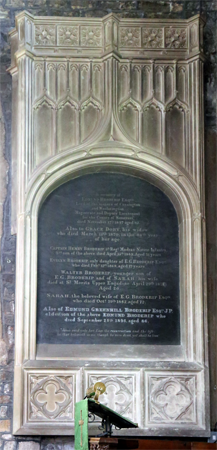 |
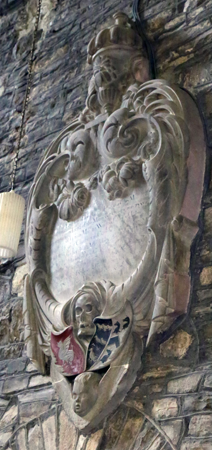 |
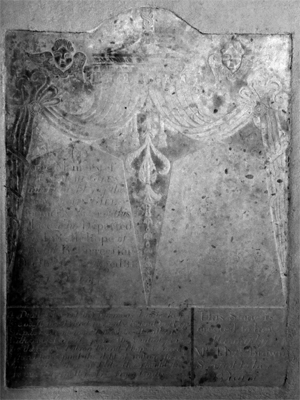 |
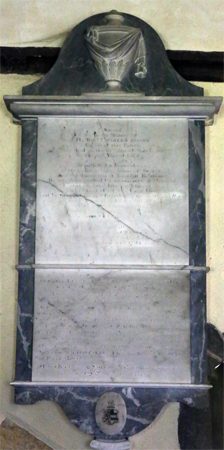 |
| Left: Edmund Broderip (1817) Magistrate, deputy lieutenant etc; His wife, Grace Dory (1870); and son, Cpt Henry Broderip (1847) 5th Reg. Madra Native Infantry. Evelyn Broderip (1868), daughter of E.G. Broderip; Walter Broderip (1870), son of . Sarah, wife of E. G. Broderip. Edmund Greenhill Broderip JP (1895) son of Edmund, above. Above left: English text but mostly illegible, especially the name. Above right: This is very faded so enhanced it. Illegible and the panel on the right has not been completed. Right: Rev Charles Hobbs Rector of this Parish. The rest is now illegible. | |||
| The faded text reports 'beneath this _ are deposited the mortal remains of three children of the Rev James Nash, curate of this parish': Mary Elizabeth (18_ aged 22 m; Elizabeth (_); and 'an infant who died shortly after his birth (1834) | Simple white slab |
| Thomas Hobbs, clerk, AM (1833), 'who succeeded his father as rector of this parish 1801' | White tablet on black base. White phoenix symbol below the tablet. |
| Amie Lennarde Most text illegible | Unrolled white scroll on black base. |
| Sarah Graham (1845) | White tablet with pilasters supporting a pediment. Arms on pediment and inverted torches on pilasters, scallop shells below. On black base. |
|
Cothelstone - St Thomas of
Canterbury Kn, L (late 14th C) Sir John Stawell (1603) & Wife Alabaster effigies |
Croscombe - St Mary James Bisse (1606) brass with family kneeling, inscripton William Bisse (1625) similar |
|
Crewkerne - St Bartholomew |
Cricket St Thomas - St Thomas
|
Creech St Michael - St Michael
|
|
|
Crowcombe - Church of the Holy Ghost |
|
| Church open during normal hours. Park in free car park immediately opposite the church. O/S Ref: ST 141 367 |
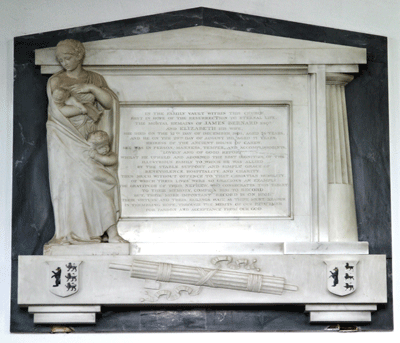 |
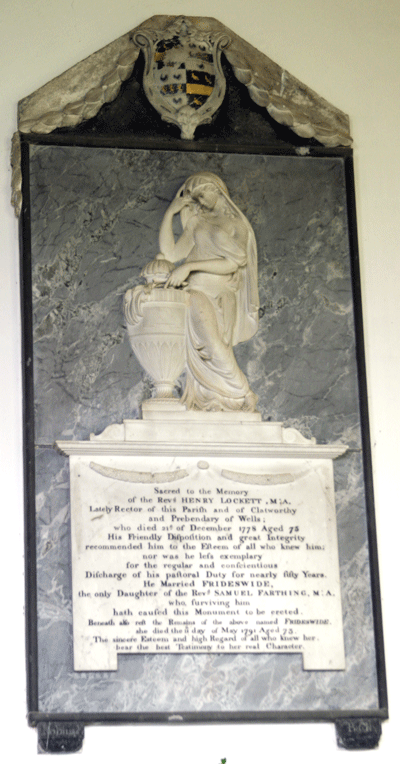 |
 |
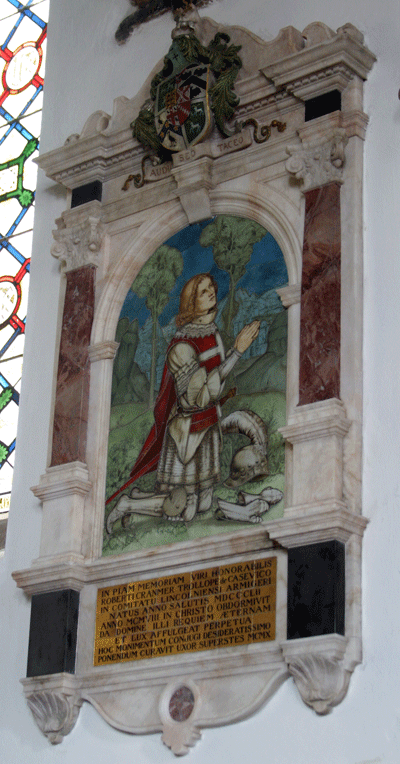 |
| Above: James (1811) &
Elizabeth (1805) Bernard.
The figure is Charity By Westmacott. (Nave) Near Right: Rev Henry Lockett MA (1778) & Frideswide (1791). He was Rector of Crowcombe & Prebendary of Wells. She was daughter of Samuel Farthing By F. Robins of Bath. (Chancel) Centre Right: Thomas Carew (1766) & Mary (1738) and Mary (1757) By Tyler (Gunnis). (Carew Aisle - N of Nave) Far Right: Robert Cranmer Trollope (1808) (Carew Aisle - North of Nave) |
| Other Wall Monuments:
John (1696) & Rebecca Farthing (1677), their son
Samuel (1731), his wife Frideswide
(1726) & their son. Both John & Samuel were rectors.
(chancel) Rev William Henry Harvey (1840) By Denham, Regents Street, London Coventry Warrington Carew (1889). Thomas Fleming Trollope-Bellew (1993) (Nave) Carew Family (16th - 18th C) five different marbles - several painted coats of arms (Carew Aisle) George Henry Warrington Carew (1842) draped sarcophagus. By Westminster Marble Co. Charles Lewis Moore & Thomas Carew Trollope who died in WWI. Brass plate with foul anchor and badge of Lincolnshire Yeomanry |
| N.B. The Carew Aisle is locked and is still owned by the family rather than by the church; however some photographs can be taken over the barrier. As well as the monuments there are many hatchments. |
|
Culbone - St Culbone |
Curry - Mallet -St James |
 |
Curry Rivel - St Andrew |
 |
| Church open until dusk. Park outside. Well worth
a visit The name 'Curry' which occurs in several village names in the area does not mean there were curry farms around here! It is from a Celtic language spoken in the region and probably means 'stream' O/S Ref: ST 392 254 |
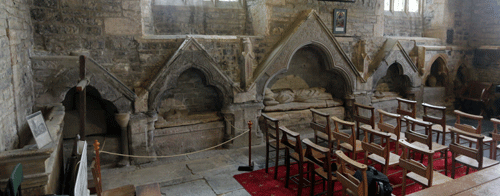
General view of the medieval tombs in the north chapel. The
Robert Jennings tomb is against the east wall and the Marmaduke
and Robert Jennings tomb divides the chapel from the
chancel
|
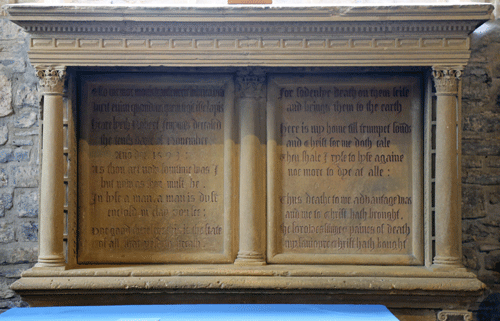
Robert Jennings (1593) This is partly
blocked in the lower part by an altar table. I have added a
photograph of the upper part so the English inscription may
be read
|
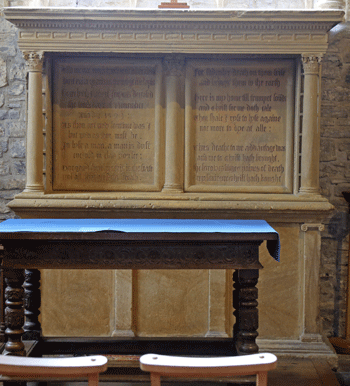 |
 |
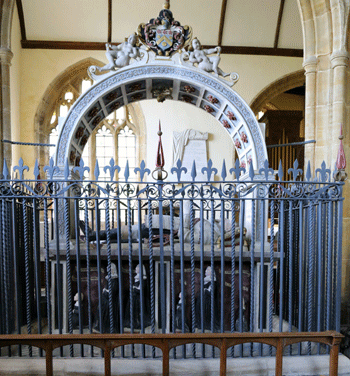 |
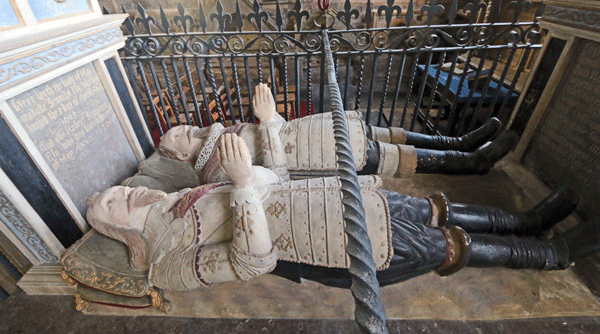 |
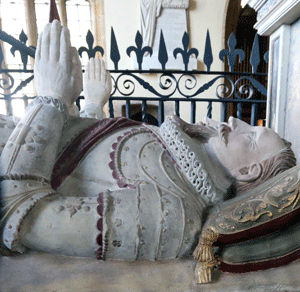 |
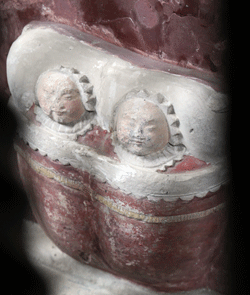 |
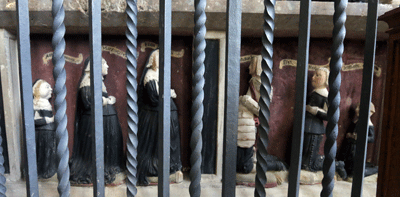 |
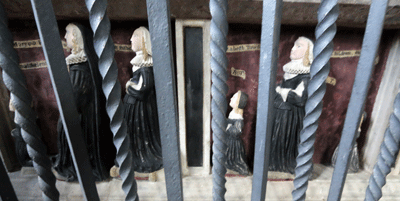 |
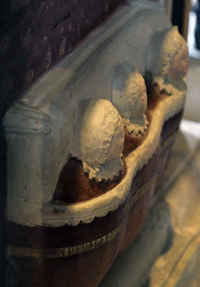 |
| Robert (1625) & Marmaduke (1630) Jennings, father and son. Note the wives and children are represented on the sides of the tomb chest; still born children (or children who died at or shortly after birth) are represented at the head and foot | |||
| Medieval Monuments |
| Arches |
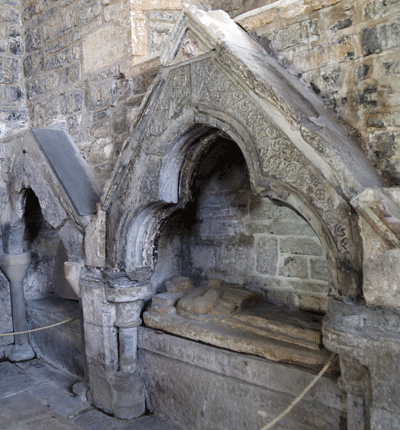 |
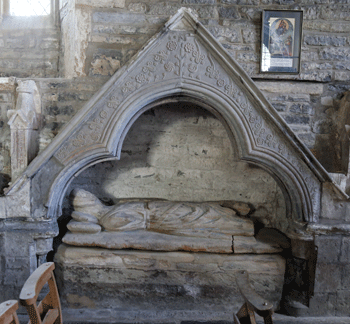 |
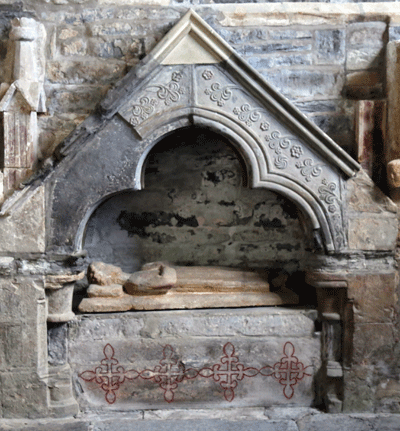 |
 See the photograph at the head of the section for the relative sizes of these arches. The one on the left and the two on the right are small and contain chests but no effigies. The knight is the largest and the two male civilians less so. None seem to fit. The eastermost structure may be an Easter Sepelchre |
| Effigies |
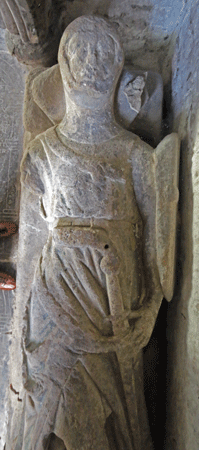 |
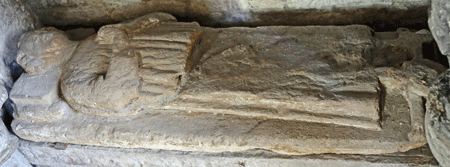 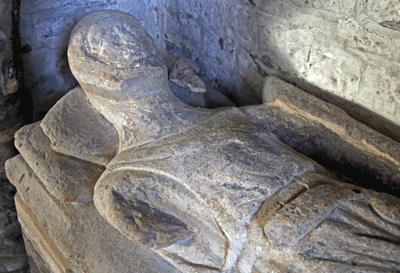 |
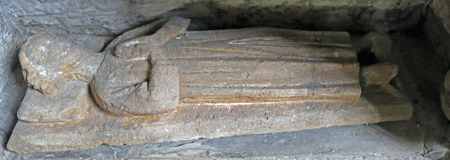 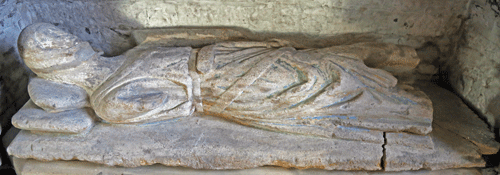 Several aspects of the knight. Above are two male civilain effigies from under the arches. To the right is a similar effigy but female civilian. Below is an incised slab (damaged) of a priest. |
 |
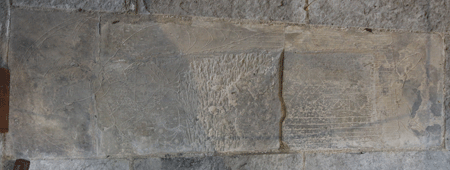 |
Local tradition has it that the knght'seffigy represents Henry
de Lorti (1242) or his grandson another Henry (1321). The
tomb chest below is said to contain the bones of the wife fo
the first Henry, Sabina Revel, whose family came from Revel
in SW France and who give the name to the village.
|
